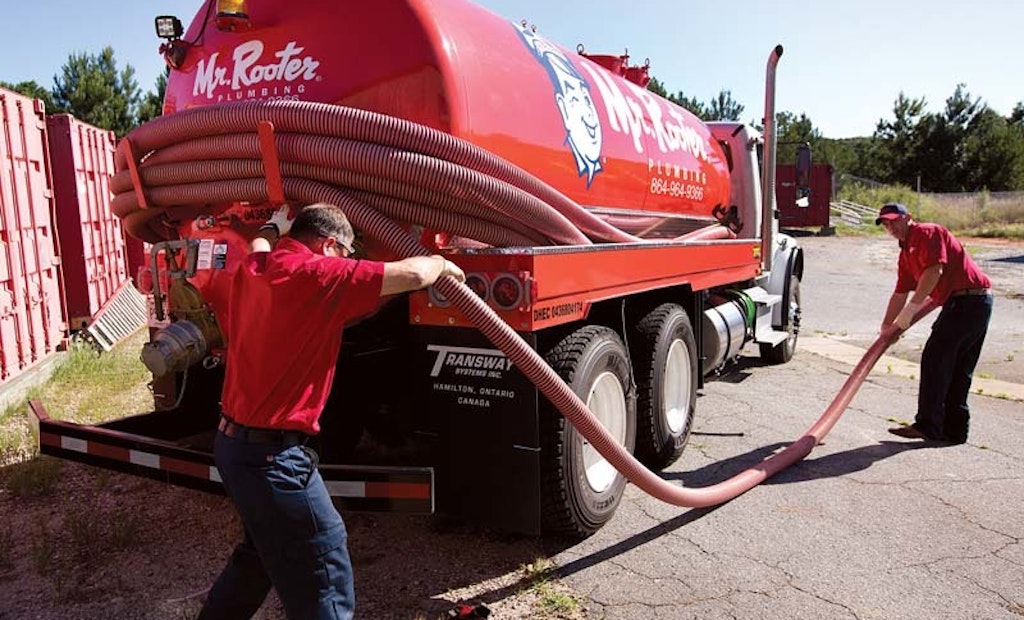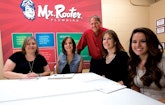
Interested in Plumbing?
Get Plumbing articles, news and videos right in your inbox! Sign up now.
Plumbing + Get AlertsSending work to subcontractors never made much business sense to Bob and Danielle Beauregard, the owners of a Mr. Rooter plumbing and drain cleaning franchise in Anderson, South Carolina. As a result, their business now offers septic pumping services, too — a move that’s boosted revenue by about 20 percent since 2012.
Adding pumping to plumbing made perfect sense to the couple, who bought the Mr. Rooter franchise in 2009 and primarily serve residential customers. Their franchise territory is more rural than urban, so many homes rely on septic systems. Moreover, many plumbing problems they encounter are directly related to issues with septic tanks, drainlines and drainfields.
“We found that plumbing is tied directly into septic systems,” says Bob Beauregard, 48. “But whenever we’d find a plumbing issue that was tied to septic, we had to call in a septic pumper.
“It kept getting more and more painful to keep handing work over to septic pumpers,” he continues. “You pay for advertising to get customers to call you, but then you have to call someone else to pump the septic tank. Then the customer sees the pumper there and calls that company next time instead of you.”
Beauregard says it’s easier and more cost-effective to provide multiple services for one customer rather than trying to sell just one service to as many different people as possible. “Providing one-stop shopping is actually a form of customer service,” he explains. In addition, it also allows him to better control workflow because he no longer has to wait for subcontractors to arrive on job sites.
STARTED YOUNG
Beauregard has been interested in plumbing since he attended Blackstone Valley Regional Vocational Technical High School in Massachusetts, where he grew up. After graduation, he worked for several plumbing outfits while earning a master plumber’s license. In 2007, the couple moved to South Carolina and established B & D Plumbing and Home Repair, with a strong emphasis on providing customer service, which he felt was lacking in the markets where he’d worked before. Two years later, they established the Mr. Rooter franchise.
After his epiphany about septic pumping, Beauregard bought a used pump truck in 2012. He still owns the truck, a 2002 Sterling outfitted by Transway Systems with a 2,500-gallon steel tank and a Fruitland Manufacturing vacuum pump.
“We wanted to buy a used truck to get our feet wet, then go to a more expensive truck after we knew we could make a go of it,” Beauregard explains. In addition, starting with a brand-new truck would’ve required charging higher rates in order to make the payments, which meant potentially pricing the company out of the market, he adds. “You have to keep your rates competitive.”
Feeling firmly established, the company bought a new 2016 Freightliner pump truck last year. Outfitted by Transway Systems, the new truck features a 3,600-gallon steel tank, a Transway water jetter (11 gpm/2,500 psi), a fan-cooled Eliminator vacuum pump (396 cfm) made by Fruitland Manufacturing, an Allison automatic transmission and rear tandem axles with locking differentials.
The Beauregards also decided to repair and install septic systems because they already owned excavation equipment used to put in residential water and sewer lines. Moreover, there aren’t many installers in the area and profit margins are higher on repairs and installations.
ADD SERVICES, ADD EQUIPMENT
When installing new systems, Beauregard says the company uses plastic tanks and EZflow drainfield systems from Infiltrator Water Technologies. The plastic tanks are convenient to transport on a trailer. “We also don’t have to wait for a truck crane to come and lower in a concrete tank,” he adds.
The transition from plumbing to pumping went smoothly because Beauregard already knew how to install drainfields. “I felt pretty comfortable within three to five months,” he says. “It’s not like I didn’t know anything about septic systems when I started.” He had to pass a state test to get a license for septic installation, repair and pumping.
After almost four years, Beauregard estimates 60 percent of septic-related revenue comes from pumping and the balance from installations and repairs. To perform the latter, the company relies on a Bobcat 324 mini-excavator, a Bobcat E50 excavator, a Kubota D3200 backhoe, a trencher made by Ditch Witch (a Charles Machine Works Co.), a dump trailer made by Load Trail, and four flatbed trailers, two made by Centreville Manufacturing and two by Big Tex Trailers.
The company also owns a Crust Buster tank agitator from Schmitz Bros.
On the plumbing side, the company utilizes one US Jetting trailer-mounted water jetter (4,000 psi/10 gpm), five Spartan 300 and five Spartan 100 cable drain cleaning machines, a Spartan Provision pipeline inspection camera and a Spartan pipe locator, four mini-SeeSnake inspection cameras, and one SeekTech SR-20 pipe locator from RIDGID.
For plumbing service vehicles, the company runs four Chevrolet box trucks with bodies made by Superior Truck & Equipment Products, a Ford F-350 and a Ford F-450 outfitted with Spartan truck bodies made by Supreme Corp., and a Ford E-350 cargo van. Plumbing technicians primarily use RIDGID or Milwaukee Tool cordless tools.
KEEPING A TOP TEAM
Customer service is critical to Beauregard. “We give people the time they need to get all their questions answered thoroughly,” he says. “And we do little things, like showing up when we say we’re going to show up and answering the phone when customers call. There’s nothing more aggravating than to get an answering machine when you have a problem.”
To improve efficiency, the company initially cross-trained its two most experienced plumbers — Greg Condrey and Alfonso Dimas — to perform septic work. That means if technicians have a problem, they’re not stymied if Beauregard is too busy to respond, because Condrey and Dimas can answer questions, too. In addition, the two technicians can diagnose problems more easily if a plumbing issue turns into a septic issue.
It worked in reverse for employee Chris Norton, who started as a septic pumper and was recently promoted to plumbing technician. Helper Andrew Dockins, who works on the plumbing side, is also being trained to drive the septic truck.
Danielle Beauregard is the office manager and Bob gives her much of the credit for growing the business.
Professional appearance is key. To accomplish this, the company runs lettered trucks and technicians must wear Mr. Rooter uniforms (blue pants, red shirts), which also helps with branding. “We want customers to know who’s coming into their houses,” Beauregard explains. “We also do background checks and hire people with good attitudes who can be trusted. If they’re not professional, they won’t treat customers and property with respect, which in turn hurts repeat business.”
Just like many contractors, Beauregard says it’s difficult to find enough qualified technicians. Word-of-mouth referrals work best, he notes.
To retain good employees, Beauregard says he and Danielle treat workers like family; for example, on most Friday mornings, he either cooks breakfast for employees or brings in carry-out food. “We treat them right — the way we’d want to be treated,” he says. “I’m a plumber by trade, so if my guys are out on the job and they need help, I go out and help. It shows them that I care. If there’s an issue, I’m going to get just as dirty as they are.”
Employees also receive benefits such as paid vacations and holidays and end-of-the-year bonuses.
ON THE HORIZON
Peering ahead three to five years, Beauregard says he’d like to get two more technicians cross-trained to do both plumbing and septic work. In addition, he’s aiming for 10 to 15 percent annual growth in revenue. The company has posted more than 20 percent annual revenue growth almost every year since its inception.
In the long term, the Beauregards would like one or both of their sons — Kyle, 12, and Trevor, 10 — to work for the company and eventually take over. Both boys already enjoy riding along on customer calls and Trevor shows an aptitude for plumbing work, Beauregard says.
“It’s a family business that Danielle and I started, so it would be great to see the kids continue it — keep growing it for their own futures,” he says. “But we’re not going to force them into it.
“On the other hand, we don’t want them to graduate from high school and start running the business,” he continues. “They’ll have to come up through the ranks like everyone else. They need to see how hard it is to run a business. Nothing has meaning in life if you don’t earn it.”









